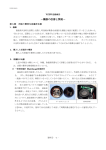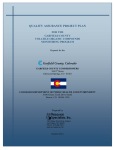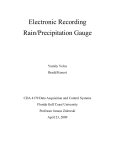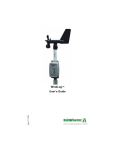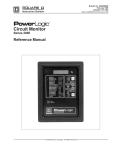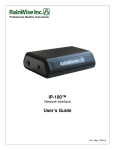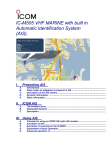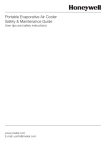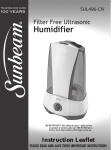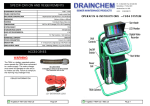Transcript
Installation and Operation of the RainWise RainewTM Wireless Rain Gauge Installation Instructions 1. The rain gauge has been designed and tested to operate at 300 feet line of sight. However, this distance may be shortened dramatically by obstacles, power lines and the new energy efficient window glass. In order to obtain consistent, reliable operation the following guidelines must be observed: a. Try to locate the gauge in an open spot away from trees, but as close to the house as possible. b. The gauge should be mounted on a flat level surface at least three feet above the ground and should not be mounted on steel or iron. c. Locate the receiver/counter inside the house on an outside wall as close to the gauge as possible. Note that any changes to the transmitting circuit board assembly or antenna are not approved by RainWise Inc. and could void the users authority to operate the Wireless Rain Gauge. 2. Back out the screws holding the collector in place until it can be rotated to a point where it may be removed. Remove the collector. Do not fasten the gauge in place yet. 3. Remove the blue cap covering the transmitter cup. Leave the desiccant in place. 4. Lift out the battery holder and install 2 alkaline AA batteries. 5. Replace the blue cap over the transmitter cup. 6. Position the rain gauge so that the antenna is aimed at the house; the strongest radio signal is achieved if the antenna is not obstructed by the gauge. 7. Install the antenna in the receiver by screwing it into the printed circuit board through the hole in the top of the case. Tighten the thumb screw. 8. Install 3 “AA” batteries in the display. Be sure to install the batteries with the correct polarity. 9. Zero the counters by pressing the button on the front. 10. Slowly tip the bucket back and forth by hand. Do this more than 10 times. After 90 seconds you should see at least a count of 10 on the 100ths display (and 1 on the 10ths) The transmitter is activated at the first tip and each tip count is sent to the receiver approximately every 8 seconds (4 seconds transmitting, 4 seconds off per tip.) Continue tipping until you have at least 20 tips. If the count on the top counter equals the number of bucket tips then the location for the gauge is okay. If the counter does not count or if the count is less than the number of tips, the gauge must be moved to a different location. . . either closer, sideways or both. Be sure to orient the gauge to the house as shown in Figure #1. 11. When a satisfactory location is obtained you may fasten the gauge in place with the four screws provided. Place the collector over the base and rotate until the ears are lined up with the four screws. Tighten the four screws. Figure #1 12. Reset both counters. To synchronize the two counters, press the reset button on the back of the display using the eraser end of a pencil. Do not use anything metal. Operating Instructions The display has one counter that counts in 100ths of an inch and one that counts in 10ths of an inch. The 100ths counter may be reset at any time without affecting the 10ths counter. To ensure that the 100ths counter is synchronized with the 10ths counter when resetting both, press the reset button on the back of the display using the eraser on a pencil. This will ensure that the 100ths counter is synchronized with the 10ths counter. When the bucket in the rain gauge tips, either from rainfall or by manual actuation, counts can take up to 8 seconds to appear. This means that if you are tipping the bucket back and forth to check the gauge, you will not see counts equaling the number of tips for about 8 seconds times the number of tips. For example, if you tip the bucket seven times, it will take approximately 56 seconds to show seven counts. Collector Batteries: The rainfall collector transmitter requires 2 AA alkaline batteries. These batteries will last well over a year. It is however recommended that they be changed annually. Display Batteries: The display requires 3 AA batteries and these should last approximately 9 months. To ensure reliable, continuous operation it is recommended that these batteries be replaced every six months. The display also uses two #357 button cell batteries. These batteries will last for a number of years and only need to be replaced when the displays go blank. You will need remove the back of the display to change these batteries. Maintenance: The rain collector will normally require periodic cleaning. There is no specific interval because this is determined by the environment in which the collector is used. To clean the collector, loosen the 4 securing screws and remove the top of the collector. A small screen is held by a cotter pin. Remove the cotter pin and screen. Debris and algae can restrict the flow of water through the hole. Clean the collector and tipping mechanism using warm water. When reinstalling the screen and cotter pin make sure that the cotter pin legs are bent up. If left down they can interfere with the tipping mechanism. The collector can be left outdoors all year. It will not be damaged by typical snow or ice. Warranty Our rain gauges have a lifetime warranty on the gauge. The electronic portions (transmitters, receivers, counters and switches) are guaranteed for one year. If your rain gauge requires repair, please make sure to enclose a brief note, daytime phone number and current shipping address when sending in your rain gauge. We will call with your repair estimate. If you have a problem with your Rainew wireless gauge, call the factory at 1-800-762-5723. Do not contact the dealer or catalog company. Rainew Wireless 030807
